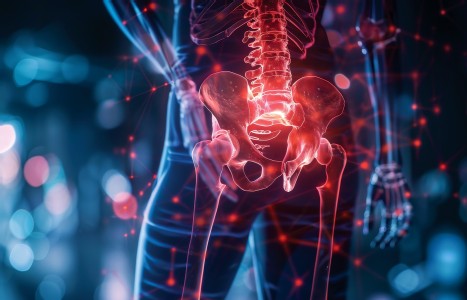Pelvic pain has a prevalence of >25% in women and >15% in men, and up to 50% of cases are undiagnosed, demonstrating that there is a definite need for pelvic care awareness among health care practitioners. As holistic practitioners, acupuncturists offer a safe space for clients and are often the practitioners clients seek out when nothing else has worked. Thus, acupuncturists are presented with an opportunity to serve an underserved population.
Treatment of PTSD: An Opportunity for the Practice of Integrated Medicine
Post-traumatic stress disorder (PTSD) is widespread across America today. Not only do many of our honored men and women in uniform bring it home with them from the war zones they have been active in, but it often follows any life-threatening event people go through when their lives have been in danger. Due to the proven effectiveness of acupuncture and other modes of Chinese medicine in treating this condition, we have an opportunity to team up with Western physicians, psychiatrists, and psychologists in providing safe, effective therapy for these suffering individuals. Often, a combined approach to treatment is best.
What causes PTSD?
PTSD develops after a terrifying ordeal that involved physical harm or the threat of physical harm. The person who develops PTSD may have been the one who was harmed, or the harm may have happened to a loved one, or the person may have witnessed a harmful event that happened to strangers. This diagnosis often applies to war veterans, but it may also involve non-military individuals who have been the victims of rape, muggings, severe auto accidents, train or airplane crashes, earthquake, hurricane, tornado, or tsunami victims, etc. It may also involve those who are first responders who have to handle mangled bodies or body parts, or therapists who recurrently deal with child abuse.
When in danger, it's natural to feel afraid. This fear triggers many split-second changes in the body to prepare to defend against the danger or to avoid it. This "fight-or-flight" response is a healthy reaction meant to protect us from harm or to enable us to cope with it. Our sympathetic nervous system is turned on and the amygdala-hypothalamus-pituitary-adrenal hormonal axis is activated, flooding our bodies with cortisol, epinephrine, serotonin, and dopamine. In post-traumatic stress disorder, this normal reaction is changed or damaged. People who have PTSD may have had the normal stress reaction so ingrained by the intense trauma, that they feel the stressed or frightened reaction even when they're not presently in danger. It is a carry-over from a past trauma that the person continues to re-live, also leaving them hyper-vigilant and jumpy.
Brain Chemistry Changes
Currently, many scientists are focusing on genes that control proteins that play a role in creating fear memories. Understanding how fear memories are normally created may help to refine or find new interventions for reducing the symptoms of PTSD. For example, PTSD researchers have pinpointed genes that make stathmin and GRP. Stathmin is a protein needed to form fear memories. In one study, mice that did not make stathmin were less likely than normal mice to "freeze," a natural, protective response to danger, after being exposed to a fearful experience. They also showed less innate fear by exploring open unprotected spaces more willingly than normal mice. GRP (gastrin-releasing peptide) is a signaling chemical in the brain released during emotional events. In mice, GRP seems to help control the fear response, and lack of GRP may lead to the creation of greater and more lasting memories of fear. Researchers have also found a version of the 5-HTTLPR gene, important in the fear response. This gene controls levels of serotonin, a neurotransmitter related to mood-that appears to fuel the fear response. Like other mental disorders, it is likely that many genes with small effects are at work in PTSD.
Brain Areas Involved
Studying parts of the brain involved in dealing with fear and stress also helps researchers to better understand possible causes of PTSD. One such brain structure is the amygdala, known for its role in emotion, learning, and memory. The amygdala appears to be active in fear acquisition, or learning to fear an event, such as an encounter with an aggressive person or an aggressive dog. The amygdala is also active in the early stages of fear extinction, or learning not to fear something. The amygdala-hypothalamus-pituitary-adrenal hormonal axis is activated in the fear response. The prefrontal cortex is also involved in fear responses and in removing fear responses with therapy.
Predisposing Factors
Environmental factors, such as childhood trauma, childhood head injury, or a history of mental illness in childhood may further increase a person's risk by affecting the early growth of the brain. At any age, personality and cognitive factors, such as optimism and the tendency to view challenges in a positive or a negative way, as well as social factors, such as the availability or lack of availability of social support, appear to influence how people adjust to traumatic experiences.
Symptoms
The core of PTSD is recurrent, involuntary, and intrusive memories of the trauma that the person cannot control. Traumatic nightmares might occur, affecting adults as well as children with PTSD. Children who are prone to nightmares anyway, may have frightening or terrifying dreams without any content related to the trauma. Dissociative reactions (e.g., flashbacks) may occur, on a continuum from brief, occasional episodes to complete loss of consciousness. Intense or prolonged distress may occur after exposure to anything that reminds the patient of the trauma in any way. There may be marked physiologic reactivity after exposure to stimuli that mimic that of the original trauma. For example, earthquake victims may startle and experience heavy breathing or a rapid heat rate when an air conditioner starts up, or they hear a car or motorcycle starting up outside.
There may be persistent effortful avoidance of distressing trauma-related stimuli after the event. The person may therefore be afraid of feeling happy or excited about something, or they may try to blunt their sad reaction to something like the news of the death of a friend or family member. They may steadfastly try to avoid anything that might remind them of the trauma – military uniforms, firearms, binoculars, backpacks, etc. They may show an inability to recall key features of the traumatic event (dissociative amnesia; not due to head injury, alcohol, or drugs).
The PTSD victim may have persistent (and often distorted) negative beliefs and expectations about themselves, or the world in general (e.g., "I am bad," "The world is completely dangerous"). They may have persistent distorted blame of themselves or others for causing the traumatic event or for the resulting consequences. They may feel alienated from others (e.g., detachment or estrangement). They may have irritable or aggressive behavior, reckless behavior or self-destructive behavior. They may have problems in concentration or may suffer a sleep disturbance.
Treatment
Re-framing exposure therapy helps patients with PTSD visit places and people in reality or in their mind that are reminders of the trauma and they can then develop new ways of reacting and new coping skills. With proper support this can be very helpful. However, expert opinion is divided about whether it is generally best to pursue such exposure therapy (again, the patient may be guided by the therapist to re-visit the traumatic situation in his/her mind) or if it is best to avoid such exposure and concentrate on coping skills. A survey of veterans conducted by the pentagon concluded that the majority of veterans would rather not re-visit the sources of their PTSD.
Cognitive behavioral therapy (CBT) is very popular. Goals of CBT psychotherapy include:
- To be able to use relaxation and anger control skills.
- Provide tips for better sleep, diet, and exercise habits.
- Help people identify and deal with guilt, shame, and other feelings about the event.
- Focus on changing how people react to their PTSD symptoms.
Pharmacological Treatment
The U.S. Food and Drug Administration has approved and recommended two medications for treating adults with PTSD: sertraline (Zoloft) and paroxetine (Paxil). Other antidepressants such as fluoxetine (Prozac) and citalopram (Celexa) can also help people with PTSD feel less tense or sad. Escitalopram oxalate (Lexapro) is also popular because it treats anxiety as well as depression. Benzodiazepines are also utilized, such as Valium and Xanax. These psychiatric drugs all have side effects, including a small but real percentage of patients (2% to 4%) who may become suicidal while on these medications. Hopefully, psychiatrists are alert to spot the initial signs that their patient might be entering such a suicidal phase. One might surmise that an approach to treatment that does not include pharmacologic medications does seem desirable.
Acupuncture
Acupuncture has been shown in several studies to be effective in treating the symptoms of PTSD. Auricular acupuncture has been especially popular. As a proponent of integrating both eastern and western medicine in treating physical and/or mental illness, I would like to see a combined approach whenever possible to the treatment of this heartbreaking illness; one that can fracture families as well as individual lives. If a veteran or someone else suffering from PTSD could be treated by an integrated team of therapists, this could do much to help him or her safely put their traumatic experiences behind them in the past, where they belong. This important illness seems like an ideal one for such a team approach.


